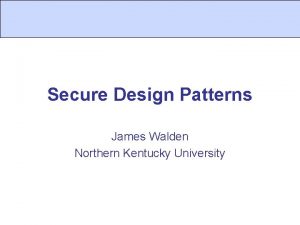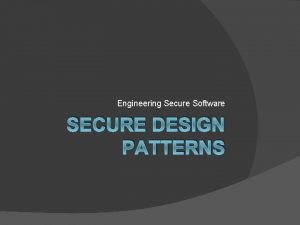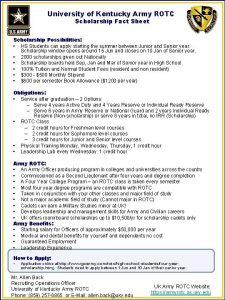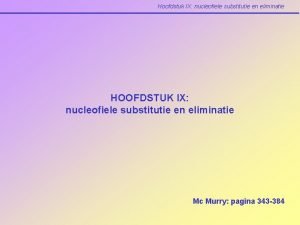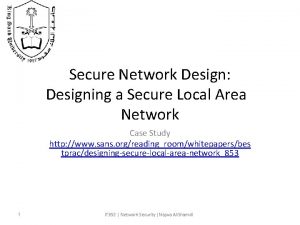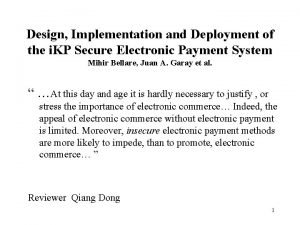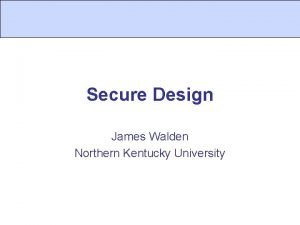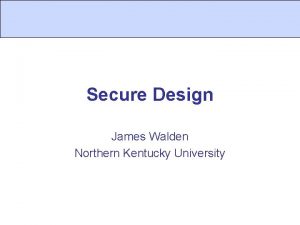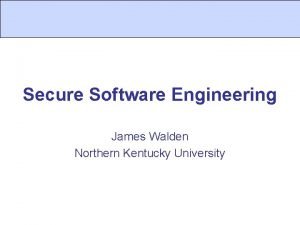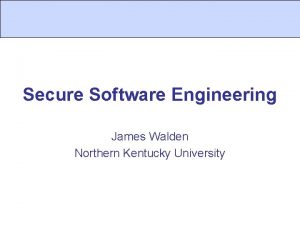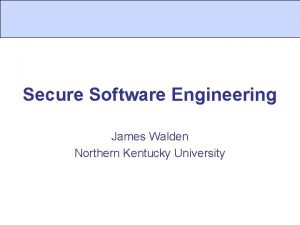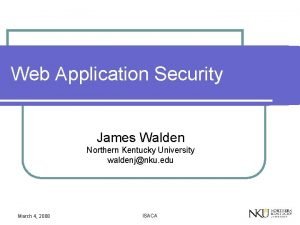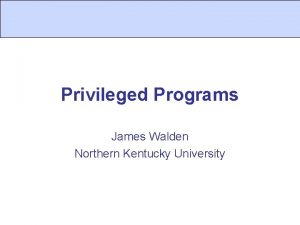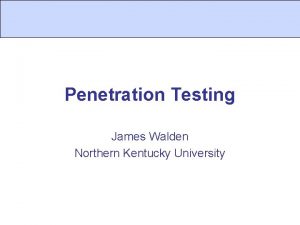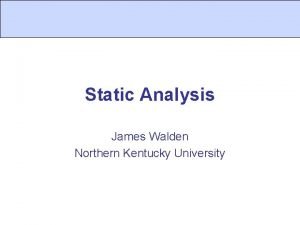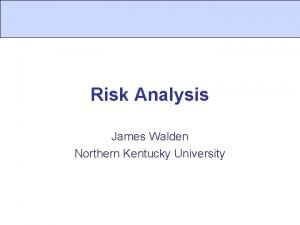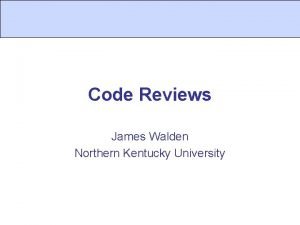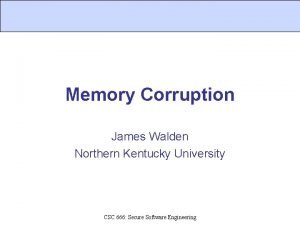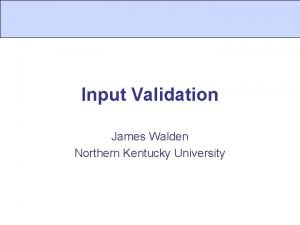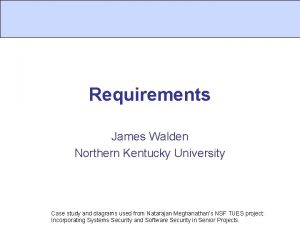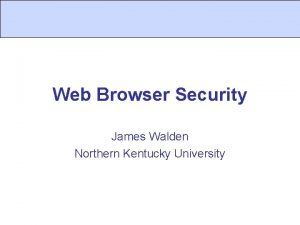Secure Design Patterns James Walden Northern Kentucky University


























- Slides: 26

Secure Design Patterns James Walden Northern Kentucky University

Topics 1. 2. 3. 4. 5. Design Patterns Security Patterns MTA Architecture Example Open. SSH Architecture Example Pattern. Share Patterns CSC 666: Secure Software Engineering

Design Patterns § A solution to a problem in context that can be re-used in different ways in software. § § Standard name Concise summary of problem Description of solution, usually with UML Examples of pattern in use § Pattern variations § Architectural patterns § Antipatterns § Pattern languages CSC 666: Secure Software Engineering

Security Patterns § A solution to a recurring security problem. § Often are not design patterns with UML. § Scope § § Design principle Architectural Procedural Design CSC 666: Secure Software Engineering

Mail Transport Agent MTA Requirements § § Receive mail from local users Receive mail from remote users Deliver mail to local users Send mail to remote users CSC 666: Secure Software Engineering

Security Requirements of a MTA Administrative access required for § Opening port 25 for SMTP. § Delivery of mail to local users. Administrative or group account needed to § Create files in mail queue. § Delete files from mail queue. CSC 666: Secure Software Engineering

Architecture of Sendmail Monolithic program performs all tasks § § Always runs as root. Drops privilege when unnecessary. Large code base. Complex configuration files. Security history § Debug command exploited by Morris worm. § Many remote root exploits. § Last root exploit in 2006. CSC 666: Secure Software Engineering

Architecture of qmail CSC 666: Secure Software Engineering

Pattern: Compartmentalization § Problem: A security failure in one part of a system allows another part of the system to be exploited. § Solution: Put each part in a separate security domain. Even when the security of one part is compromised, the other parts remain secure. CSC 666: Secure Software Engineering

Pattern: Distributed Responsibility § Problem: A security failure in a compartment can cahnge any data in that compartment. A compartment has both an interface that is at risk of a security failure and data that needs to be secure. § Solution: Partition responsibility across compartments such that compartments that are likely to fail do not have data that needs to be secure. Assign responsibilities in such a way that several of them need to fail in order for the whole system to fail. § AKA: Distributed Delegation CSC 666: Secure Software Engineering

qmail queue § All messages stored in queue first. § Queue is accessible only by qmailq user. § Subdirectories § pid: initial location of messages; files named after process ID of qmail-queue process § mess: second location of messages; files named after inode to ensure uniqueness § intd: contains envelopes for each message § todo: links to envelopes to be delivered CSC 666: Secure Software Engineering

Pattern: Unique Atomic Chunks § Problem: Many processes need to add information to a database concurrently. How do we ensure that multiple write operations are handled correclty and even if there is a crash no trace is left of the failure? § Solution: Ensure that every write request is to a different location. Thus, different processes are never writing to the same file at the same time. CSC 666: Secure Software Engineering

Pattern: Checkpointed System § Problem: A component failure can result in loss or corruption of state information maintained by the failed compmonent. How can we design a system so that its state can be recovered and restored to a known valid state in case a component fails? § Solution: Design the system as a finite state machine. Make the state information persistent. Use configurations that provide ability to restart system from known valid state. CSC 666: Secure Software Engineering

Architecture of Postfix Uses many of same patterns as qmail. § Compartmentalization § Distributed responsibility Adds focus on compatibility § Uses mbox as well as maildir format. § Violates Unique Atomic Chunks in mbox mode. Adds focus on performance § Qmail uses processes for single delivery. § Postfix processes last longer. § Uses Secure Preforking pattern. CSC 666: Secure Software Engineering

Pattern: Secure Preforking § Problem: The consequences of security compromise are worse in the case of daemon processes because they have a long lifetime. How can the vulnerability associated with daemon processes be reduced? § Solution: Limit the lifetime of daemon processes and fork them again after a configurable, short lifetime. Run the daemons in a contained environment to minimize the exploits. CSC 666: Secure Software Engineering

Architecture of Open. SSH login requires privileges to § § Open port 22. Access host key and password information. Open new pseuo-terminal devices. Change UID to that of user logging in. Privilege separation § Divide SSH into multiple processes. § Operate at root, user, and unprivileged levels. § Limit scope of exploit. CSC 666: Secure Software Engineering

Architecture of Open. SSH Monitor § Privileged § FSM that accepts requests from child for privileged actions. Unprivileged § Handles auth requests. User-privileged § Runs as user once user authenticated. CSC 666: Secure Software Engineering

Architecture of Open. SSH Patterns Followed § Compartmentalization § Least Privilege § Reducing the TCB Comparisons § Much more interaction btw priv/unpriv than qmail or postfix. § Very Secure FTPd (vsftpd) follows a privilege separation approach too. CSC 666: Secure Software Engineering

Broad classification using information organizing table Viewpoint Pattern. Share Template – Pattern Name Interrogative Classification Key: Hierarchical classification key Problem The problem statement of the pattern. Solution The solution provided by the pattern. Known Uses. Example implementation of the pattern. Related Patterns that are related. Source: Source Repository Tags: Tags for identifying the pattern CSC 666: Secure Software Engineering Munawar Hafiz, Security Patterns and Secure Architecture, OOPSLA ‘ 06

Viewpoint Pattern. Share Legends Interrogative Viewpoints Business Arch. – CEO – Integration Arch. – Ent. Arch. Application Arch. – Arch. – Application Arch. Design - Application Arch. – Developer Operational Arch. – Sys. Arch. - Interrogatives Function – Data - Network - Test - Everything - CSC 666: Secure Software Engineering

Application Architecture Pattern Application Arch. – Design Audit Interceptor Data Classification Key: Core Security, Repudiation Problem A security audit allows auditors to reconcile actions or events that have taken place in the application with the policies that govern those actions. The audit logs have to be checked periodically to ensure that the actions that users have taken are in accordance with the actions allowed by the user’s privileges. The most important part is to record an audit trail and making sure that the audit trail helps proper auditing of appropriate events and user actions associated. Deviations must be identified from the audit reports and corrective actions have to be taken so that the deviations do not recur, either through code fixes or policy changes. How can you make an auditing framework to easily support additions or changes to the auditing events? Solution Intercept business tier requests and responses. Create audit events based on the information in the request response pair using declarative mechanisms defined externally to the application. The declarative approach is crucial to maintainability of the application. This makes it easy to keep up with the changed corporate policies. Known Uses. Audit interceptor with a JMS store to store audit information. Source: Sun Book Tags: Audit CSC 666: Secure Software Engineering Pattern 4

Application Architecture Pattern Application Arch. Design Function Authenticator Classification Key: Perimeter Security, Spoofing Problem A malicious attacker might try to impersonate a legitimate user to have access to the user's resources. This could be even more serious if the impersonated user has a high level of privilege. How to prevent agents who are not allowed from entering the system? Solution Create a single point of access to receive the interactions of a subject and apply a protocol to verify the identity of the subject. Create a proof of identity if subject is successfully authenticated. Known Uses. Centralized authentication service in RADIUS. Related Patterns. Single Access Point, Policy Enforcement Point. Source: Wiley Book Tags: Authentication, Component CSC 666: Secure Software Engineering Pattern 5

Application Architecture Pattern Application Arch. Design Client Data Storage Data Classification Key: Core Security, Tampering Problem In a client server system, there may be necessity to store data on the client. This data storage is necessitated for load-balancing, session management, single sign on etc. The client should not have access to view the data. How can the data be protected from unauthorized access of the client? Solution Use encryption to protect the data that is stored on the client. Keep a hash value of the data to detect that the content is not tampered with. Use lightweight symmetric key to protect the data. Change the session key often to protect against guessing attacks. Known Uses. Amazon. com, Buy. com etc store encrypted cookie in the client. Related Patterns. Encrypted Storage. Source: Kienzle et. al. Repository Tags: Client Server, Access Control CSC 666: Secure Software Engineering Pattern 10

Application Architecture Pattern Application Arch. – Arch. Function Single Access Point Classification Key: Perimeter Security, Information Disclosure Problem A security model is difficult to validate when there are multiple ways for entering the application. How can we secure a system from outside intrusion? Solution Set up only one way to get into the system and if necessary, create a mechanism to decide which sub-application to launch. Typically most applications use a log in screen to accomplish the single access point. Known Uses. Login window in Windows, Unix, Mac. OS. Related Patterns. Policy Enforcement Point, Security Session. Source: Wiley Book Tags: Access Control, Policy CSC 666: Secure Software Engineering Pattern 78

Application Architecture Pattern Application Arch. – Design Function Small Processes Classification Key: Perimeter Security Problem A program memory processes can be limited by the memory used by the processes. If the processes grow unbounded, then there is a potential Denial of Service scenario. How can a program with many processes be made safe from resource exhaustion? Solution Make the processes small. Each process should perform one task. This will ensure that processes allocate limited memory. Known Uses. qmail processes are very small and they only perform the required task. Related Patterns. Do. S Safety. Source: Hafiz et. al. Tags: Resource Limit, Do. S. CSC 666: Secure Software Engineering Pattern 82

References 1. 2. 3. 4. 5. 6. 7. 8. Daniel J. Bernstein, "Some thoughts on security after ten years of qmail 1. 0", Proceedings of the 2007 ACM workshop on Computer security architecture, 2007. Munawar Hafiz, Ralph Johnson and Raja Afandi, "Security architecture of qmail. " Proceedings of the 11 th Pattern Language of Programs, PLo. P 2004. Munawar Hafiz, "Security Patterns and Secure Software Architecture, " OOPSLA Tutorial 51, OOPSLA ’ 06, 2006. Darrel M. Kienzle and Matthew C. Elder, "Final Technical Report: Security Patterns for Web Application Development, " available at http: //www. scrypt. net/~celer/securitypatterns/, 2002. Niels Provos, Markus Friedl and Peter Honeyman, “Preventing Privilege Escalation, ” 12 th USENIX Security Symposium, Washington, DC, August 2003. Jermone H. Saltzer and Michael D. Schroeder, "The Protection of Information in Computer Systems, " 1278 -1308. Proceedings of the IEEE 63, 9 (September 1975). Markus Schumacher at. al. , Security Patterns—Integrating Security and Systems Engineering, Wiley, 2006. Joseph Yoder and Jeffrey Barcalow, "Architectural Patterns for Enabling Application Security. " Proceedings of the 4 th Conference on Patterns Language of Programming (PLo. P’ 97), 1997. CSC 666: Secure Software Engineering
 James walden md
James walden md Secure design patterns
Secure design patterns Secure design patterns
Secure design patterns Walden university fnp clinical hours
Walden university fnp clinical hours Walden security
Walden security Disability resource center uky
Disability resource center uky Kentucky state university mascot
Kentucky state university mascot Eku aviation
Eku aviation University of kentucky axolotl
University of kentucky axolotl Education abroad uky
Education abroad uky Ukcom curriculum
Ukcom curriculum Uky rotc
Uky rotc Elektrofiel en nucleofiel
Elektrofiel en nucleofiel Walden ultrasound
Walden ultrasound Kirk walden
Kirk walden Mla format high school
Mla format high school Walden iop
Walden iop Nau family housing
Nau family housing Nau blackboard
Nau blackboard Disorganized crime scene
Disorganized crime scene Clay lawson and russell odom
Clay lawson and russell odom Dating serves several important functions that include
Dating serves several important functions that include X videos
X videos Secure network design example
Secure network design example I kp
I kp James madison rotc
James madison rotc James walsh brown university
James walsh brown university

